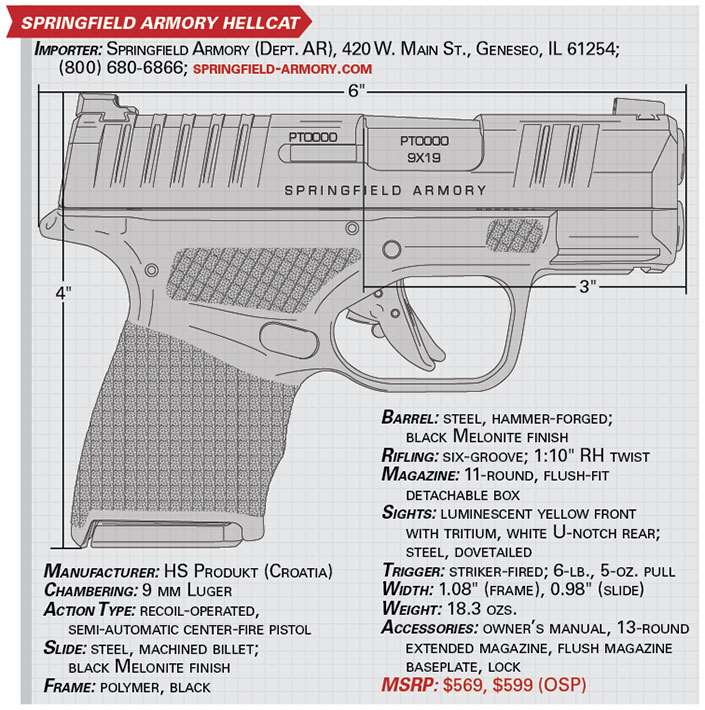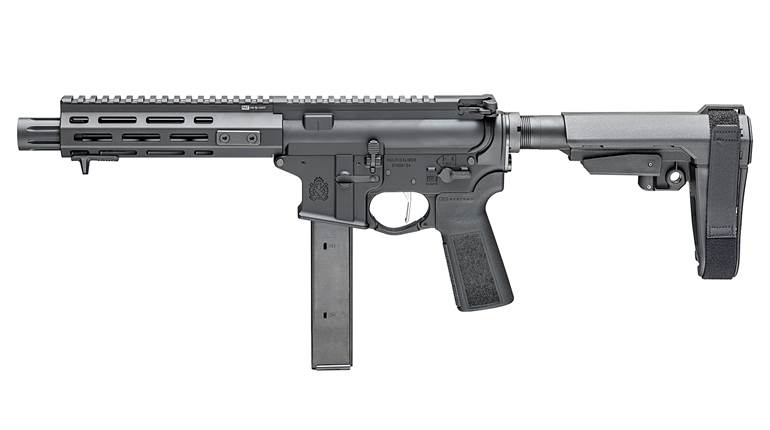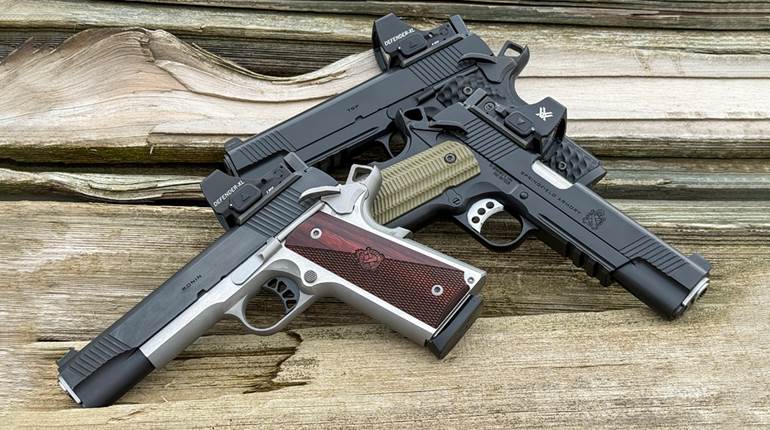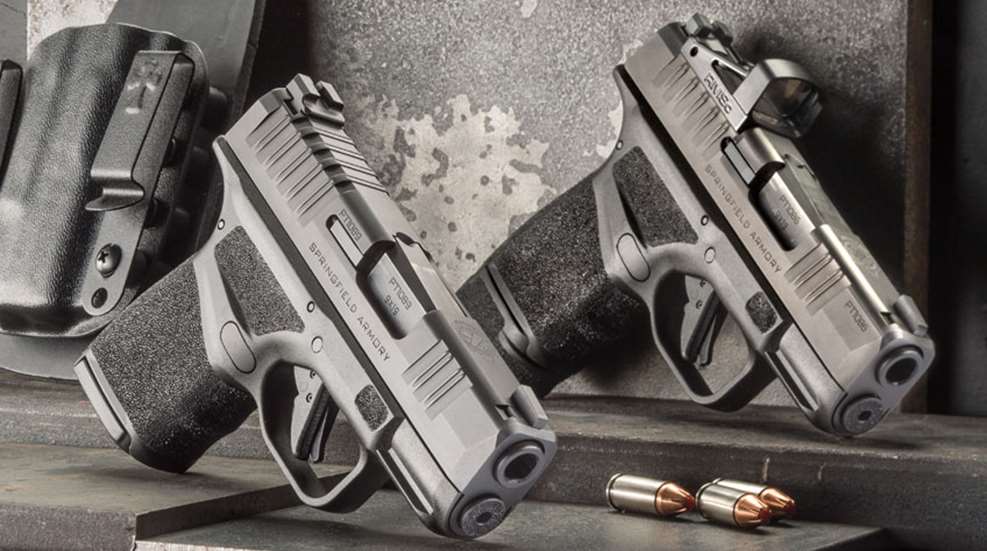
I’m not exactly sure who decided that small, semi-automatic pistols previously restricted to single-stack magazines could, all of the sudden, accept double-column magazines, but the shooting public has unquestionably embraced the innovation. In fact, the first guns in this new double-stack, micro-compact category seem to be even a touch smaller than their single-stack predecessors. The size and capacity of these guns have injected excitement into the new-firearm market by offering consumers fullsize capacity in sub-, or even smaller-than-subcompact pistol packages. For concealed-carry practitioners, the “perfect gun” equation is no longer a compromise between size and capacity; today’s armed citizen can have it all.
If the new micro-compact category seemed to spring forth in deus ex machina fashion—a solution to the seemingly unsolvable CCW conundrum—the newest entrant, Springfield Armory’s Hellcat, took just a little bit longer to arrive on scene. “This project was two years in the making for us,” said Steve Kramer, vice president of marketing at Springfield Armory, speaking about the then-top-secret Hellcat pistol project. “But we knew we wanted to be in the larger-capacity micro-compact market.” To his comment, made on a conference call with American Rifleman staff, I half-jokingly replied that in today’s defensive handgun market, a two-year development period could result in the introduction of an obsolete firearm, one that’s already behind the times. “It’s a risk,” Kramer acknowledged, “but we are very excited about [the Hellcat], and we’re going to have an OSP (Optical Sight Pistol) model available at launch. We’ll be the first to do that.” A red-dot-ready micro-compact with a lot of capacity in a tiny package, I agreed, was a combination worth waiting for, as it represents the blending of the two most powerful trends in today’s handgun marketplace.
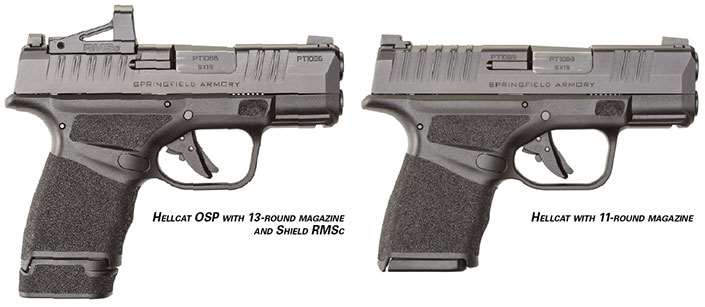
More and more, red-dot-ready pistols are becoming the norm, and their advantages are too numerous for the trend to slow or reverse. Red-dot optics are easy to see and intuitive to use, they reduce the number of sights and focal planes a shooter needs to manage, and they facilitate better accuracy at longer ranges thanks to the fine aiming point provided by their reticles. Optics-equipped pistols are the future. Period. End of story. Any shortcomings or perceived faults some may try to find with pistol-mounted optics can generally be remedied through a little bit of training and the simple inclusion of co-witnessing iron sights—if the optic goes down, you’re still ready to stand and deliver. Don’t believe me? Ask the Army; the new M17/18 platforms are red-dot-ready thanks to a rear sight/cover plate assembly similar to those used in SIG’s X-Series guns. Still not sure? Ask the manhunters of the U.S. Marshals’ tactical teams; they just adopted an STI 2011 platform equipped with a Leupold DeltaPoint Pro and co-witnessing iron sights. At this point, it’s almost passe to even report on new military or law enforcement groups going to red-dot-equipped pistols because, well, of course they are. Guns of that design are the better mousetrap, and now concealed carriers are updating their rigs as well. Whether with optics-ready production guns, aftermarket slides and adaptors, or by a quick trip to a growing number of slide-slicing custom shops, the American armed citizen is moving into the future, and the future is red-dots.
Today’s firearm enthusiasts are obsessed with the latest concealed carry handguns and CCW innovations—it’s the only firearm category that is consistently in demand even in a relatively slow market. Consumers are equally on fire for anything red-dot-ready. The combination of the two from an industry icon like Springfield Armory should, if properly executed, burn the proverbial barn to the ground. Folks, I’m here to tell you to grab a bucket and get the hose, the Hellcat does not disappoint.
A New Direction
Seeing the Hellcat’s polymer frame and crossed-cannons logo, you may be saying to yourself, “Oh look, American Rifleman is reviewing another Springfield XD.” You’d be wrong.
From the company’s CEO Dennis Reese, “This is the first step in a new direction for Springfield Armory polymer handguns, and we are excited to share it with the world.” That quote was published in the introductory material shipped with a set of guns for my evaluation. It’s an interesting quote because it indicates, quite plainly, a pivot away from a staple brand within the company’s catalog, specifically the XD line of semi-automatic pistols. Why go in a “new direction”? Why not simply introduce a new line, as was done with the XD-M match-grade pistols, or the XD-S single-stack guns? Even if the Hellcat was to be a radically different platform a la the XD-E—with its hammer-fired, rather than striker-fired, operation—certainly there was room for one more under the bustling XD canopy. The reality is, the XD line of pistols are known for certain eccentricities—such as the M1911-style grip safety—that are beloved by many, but criticized by others. The XDs also have history, tenure and a legacy that is integral to the Springfield Armory story. But the Hellcat is about the future, and, to quote Reese again, the future of Springfield Armory starts with nothing less than the “highest capacity micro-compact 9 mm handgun in the world.” Let’s dive in.
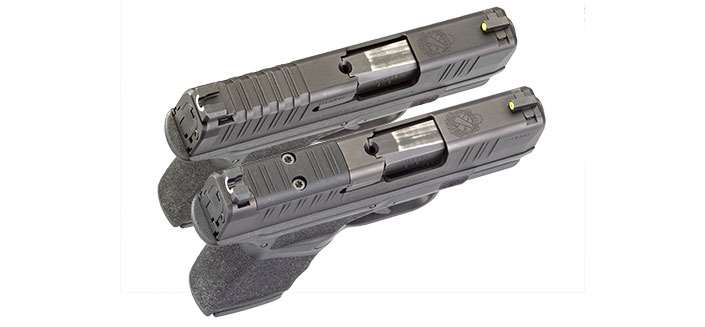
The Hellcat is a recoil-operated, striker-fired, semi-automatic center-fire pistol chambered for 9 mm Luger—with a capacity of up to 14 rounds on board. It measures just 4" tall with a flush magazine, is 6" long and weighs only 18 ozs. The gun’s uppermost component is a slide assembly—the slide itself is machined from billet steel—which houses a robust, dual-captured recoil spring assembly, a hammer-forged 3" steel barrel rifled at a twist rate of 1:10", and the striker assembly that includes a passive firing pin safety that is deactivated by the rearward travel of the trigger assembly during a deliberate trigger press. Both the slide and barrel feature a black Melonite finish, which is a chemical treatment that improves the durability and corrosion resistance of the metal. Also included in the slide is an external extractor, which is tensioned by an internal spring and pin assembly. The machined internal channels for both the striker and extractor assemblies can be accessed by removing the slide’s metal backplate. Finally, the slide is topped by iron sights mounted via machined dovetail cuts, and, on the Optical Sight Pistol (OSP) version, a cover plate secured over an optics-mounting surface by two Torx-head screws. Much more on the sighting system to come.
The Hellcat is slated to wear an MSRP of $569, so the gun is priced competitively. Better still, the OSP model is only $30 more—that’s the option I’d go with.
The Hellcat’s molded polymer frame is ergonomically well designed, incorporating subtle finger grooves, a slight beavertail and full-diameter texturing, including thoughtfully placed panels high on the frame for the meat of the support hand and textured index points above the trigger guard for the trigger finger and support hand thumb. Frame components include the trigger assembly, steel locking block insert and sear housing assembly, and the various controls—disassembly lever, slide stop and magazine release—there is no grip-, thumb- or other manual safety. The trigger itself has a near-flat engagement surface and incorporates a central blade-style trigger safety that prevents it from being fully depressed if not deactivated by deliberate finger pressure. Rails are incorporated into both the locking block and the sear housing, allowing the slide to reciprocate on appropriately hardened surfaces. And, for the lefties out there, the magazine release is reversible.
The Hellcat’s controls and operation are straightforward. An unloaded firearm is made ready when a magazine filled with cartridges is inserted into the grip frame’s magazine well and locked into place by the magazine catch. The slide is then pulled all the way to the rear and released forward—the rearward movement of the slide cocks the striker, and during its return forward, the breechface engages the rear of the magazine’s top round and pushes the cartridge forward into the barrel’s chamber. At this point the Hellcat is loaded. When ready to fire, a deliberate press of the trigger disengages the trigger safety and begins the rearward travel of the trigger assembly. During that travel, an extension in the trigger bar engages and deactivates the firing pin retention safety. At the end of its travel, the trigger bar trips the sear mechanism, releasing the striker to spring forward and impact the cartridge primer, igniting the propellant and sending the bullet down the barrel. Pressure from the shot forces the slide rearward, unlocking the barrel and camming it downward, toward the magazine and its awaiting cartridges. Power from the now-compressed recoil springs arrests rearward slide travel and sends the slide assembly forward, once again loading the chamber and locking the barrel into battery—the Hellcat is ready to be fired again. If the inserted magazine runs empty, the magazine’s follower will engage the internal tab of the slide lock lever, pressing it upward to lock the pistol open. At that point, the empty magazine can be released by depressing the magazine catch button, and its clearance makes way for another loaded magazine to be inserted, and the process continued.
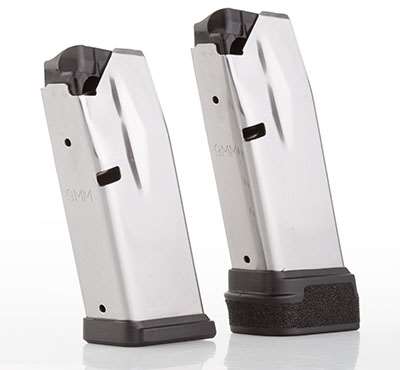
Speaking of magazines, I often say that the heart of a firearm is its barrel, but the hook for the Hellcat is its patented magazine. At launch, the guns will ship with two magazines holding 11 and 13 rounds of 9 mm Luger—considering there should be one round in the chamber when carried for personal protection, the Hellcat boasts a topped-off total payload of 12 or 14 rounds. With a full carry complement—both magazines full and a round in the chamber—the armed citizen will be well supplied with 25 rounds of 9 mm—a full box or more of defensive ammunition. The 11-round magazine is designed to fit flush in the gun, maximizing the pistol’s concealment qualities. Users can choose to equip the shorter magazine with either the flat base pad or the pinky-rest unit, which allows for a fuller firing grip without compromising the gun’s concealable profile—both base pad units are included. The 13-round magazine utilizes an extended single-piece base pad to accommodate the extra ammunition and provide real estate for a full firing grip. I was glad to see Springfield decided to use the extended base pad rather than a grip-extending collar assembly—I’ve been bitten more than once when loading a magazine whose collar had shimmied down the tube and caught the meat of my support hand. I much prefer the integral extension.
Bringing The Heat
If the Hellcat looks good on paper, it feels even better in hand, and it all starts with the grip frame. I see the Hellcat’s frame as the culmination of everything Springfield Armory and its Croatian manufacturing partner, HS Produkt, have learned about molding polymer and handgun ergonomics—if the XD-S Mod.2 was a masterpiece, the Hellcat is their magnum opus. For being such a small gun, it fills the hand well. And where some companies’ “ergonomic features” seem to influence how the gun needs to be held, the Hellcat fits naturally, unobtrusively, and melts into the embrace of a firm firing grip. The texturing, too, is perfectly on point. Advertised as “Adaptive Grip Texture,” the stippling pattern is a seemingly random array of tiny pyramids varying in height. The multi-tiered approach provides very good purchase, and the tallest of the pyramids have been flattened on top in order to keep the texturing from becoming too abrasive or clinging to cover garments. Springfield’s Kramer told me that, during a factory visit to HS Produkt, he saw a craftsman literally hand-chiseling each miniscule pyramid into the metal molding apparatus. It must be an extremely time- and labor-intensive process—and, in my opinion, worth every minute of effort.
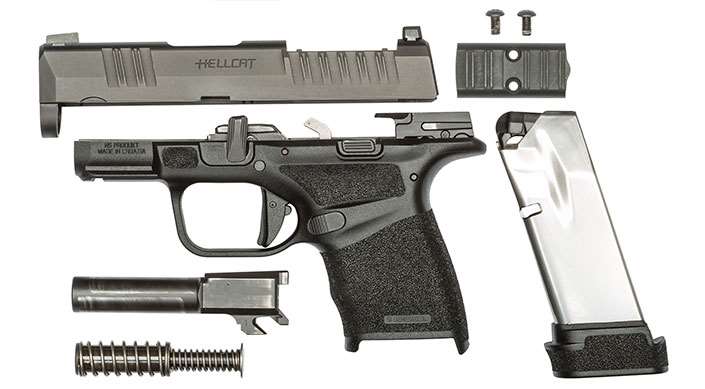
Besides its minimal carry profile in terms of size and weight, the controls have also been minimized, without sacrificing utility. The disassembly lever and slide lock lever are both recessed into the frame, and the slide lock even features a bit of fencing to help prevent inadvertent manual engagement. Despite its size, I had absolutely no problem using the slide lock as a slide release during reloads, nor did I encounter any issues with the magazine release button which sits nearly flush with the frame but does make use of vertical serrations to enhance contact. Other nods to its role as a potentially life-saving fighting pistol include the cocking serrations found front and rear, and the stand-off device, which most of us would just call the front of the recoil spring assembly. The cocking serrations are angled just slightly forward, and are made up of wide cuts separated by ridges which themselves have narrow channels down the center. The rear serrations extend all the way over the top of the slide to add grasping surface, and the forward serrations facilitate chamber checks, though the barrel and slide also have a small topside view port, machined in for just that purpose. The stand-off device protrudes a hair beyond the muzzle and could, in theory, prevent the slide from coming out of battery in a contact-shooting scenario. It also features a gritty texturing pattern on the forward face, so even if the utility is somewhat questionable, it definitely adds to the gun’s aggressive aesthetic.
Straight Fire
Ergonomics and handling are important, but the real test of a gun is in how it performs when the ammunition is live. Throughout the course of more than 1,000 rounds I thoroughly tested two Hellcats for performance and accuracy—one in an iron-sight-only configuration, the other an OSP topped with a Shield RMSc 3-m.o.a. red-dot sight. Starting with the sights, the first thing that stands out is how good they are for the intended role. The configuration is simple and effective—a big, bright, luminescent yellow dot up front paired with a white-outlined U-notch in the rear. Correctly aligning the sights is intuitive, just drop the ball into the basket. Low light? No problem, the front sight also has a tritium vial for illumination. Make no mistake, these aren’t plastic dovetail protectors as you find on some other guns, nor are they super-fine bulleye sights. The Hellcat is equipped with big, tough steel sights, and they are ideal for a small defensive pistol. I found them to be fast to acquire, easy to align, and from 3 yds. to 25 yds. they seem to be regulated for a combat or center-hold—point of aim equals point of impact. Moving to the OSP model the sighting equation gets even better. For one, you still get the excellent night sights as on the standard model. What’s better is that the irons are still completely visible when a red-dot is installed, providing a lower-one-third co-witness arrangement without requiring extra-tall irons. That’s possible because Springfield designed the optics cut correctly—a mounted optic sits down in the slide, as opposed to other setups in which the optic balances awkwardly atop the gun. Not only does such an arrangement allow for a “natural” co-witness with irons, the mounting also tends to be more secure, better protecting the optic during recoil. To be clear, the OSP ships with a cover plate installed and does not include a red-dot optic, but the slide’s mounting surface will accept the Shield RMSc and JP Enterprises JPoint, and potentially other red-dot optics of that pattern.

To get a better sense of the sighting options, I tested the iron-sight pistol for accuracy at 7 yds.—American Rifleman protocol for guns with barrels shorter than 3.5"—and the OSP model at 25 yds., which is much farther than I’d typically test a personal-defense micro-compact. Both guns were also shot extensively at varying distances for familiarization and in defensive-style drills. The results were impressive. Working from a Crossbreed Reckoning holster (crossbreedholsters.com), I found the Hellcat to be fast and accurate in drills. For close-range targets, the bold and unmistakeable yellow front sight burst into my field of vision, facilitating fast, accurate shots. In fact, when using the OSP model at shorter range, I found that I was making my initial shots using the iron sights through the optic’s viewing pane, and transitioning to the dot naturally during the course of fire. As the distances increased, the red-dot came into its element, allowing me to shoot quickly at range with confidence thanks to the finer aiming point of the RMSc’s reticle. How’s this for a skills check? Are you and your carry pistol capable of making a precise 25-yd. shot on a reduced target, from concealment, in just a few seconds? I’m not suggesting it’s a likely scenario, and I’m not advocating any defensive strategies or techniques, but in an age of terrorism and deranged criminals, wouldn’t that be a nice tool to have, should the need arise? I found in training, armed with the Hellcat, I could quickly and consistently punch the headbox of an IPSC-style target at 25 yds.—that’s confidence in hand.
Results from the bench were equally impressive. For the formal evaluation I chose three personal-defense 9 mm Luger loads with varying bullet weights: Hornady Critical Duty 124-gr. +P FlexLock—the Hellcat is rated for +P ammunition—SIG 365 115-gr. JHP and Speer Gold Dot 147-gr. JHP. At 7 yds. with the iron sights, the SIG 365 ammunition posted the best average for five, five-shot groups at 1.10", and the combined average for all three loads was 1.40". At 25 yds. with the OSP and Shield optic, SIG’s 365 ammunition again posted the best average, 2.23", and the combined average was 2.34". I’d be happy with these results in a full-size pistol, and I am deeply impressed that they were printed with a 3"-barreled micro-compact. The results could probably have been even better if the gun wore target-style sights or a lighter trigger—the average pull weight for the samples was 6 lbs., 5 ozs. Of course, I wouldn’t make those changes on a portable, concealable personal-protection pistol—the sights are ideal and the trigger is just fine for defensive-style shooting—and the data speaks for itself. The Hellcat is a shooter.
The Hellcat’s forward cocking serrations, stand-off device, excellent night sights, red-dot compatibility and generous 9 mm Luger capacity are illustrative of the rapid evolution of defensive, concealable handguns.
I do want to report an unusual occurrence that cropped up during range testing. When shooting from the bench, with the dustcover supported by a rest and the frame supported by sandbags and my hands, I was able to cause a stoppage where the slide would lock open while there was still ammunition present. The stoppage occurred at a rate of one or two per 100 rounds—again, during supported bench shooting—and I suspect the culprit was additional pressure applied by the supports, as well as the direction of the force as it acted on the base of the magazine. In a few instances, it is possible that the magazine was pushed out of alignment, and the magazine or a round within the magazine could have activated the slide lock, inducing the stoppage. Also worth reporting is that no stoppages occurred during my defensive shooting drills, so these malfunctions have not degraded my confidence. Tiny guns sometimes do weird things when shot from the bench—I’ve seen it before in other trustworthy platforms. I reported all of my malfunction data to Springfield Armory, and at writing the company was already making an adjustment to the magazine baseplates to reduce inadvertent movement in the gun.
After shooting the gun and living with it, even for a short time, I can say with confidence that I want one, and I want it yesterday. The standard Hellcat is slated to wear an MSRP of $569, so the gun is going to be priced competitively at retail. Better still, the OSP model is only $30 more—that’s the option I’d go with. (Watch Springfield's Hellcat video here.)
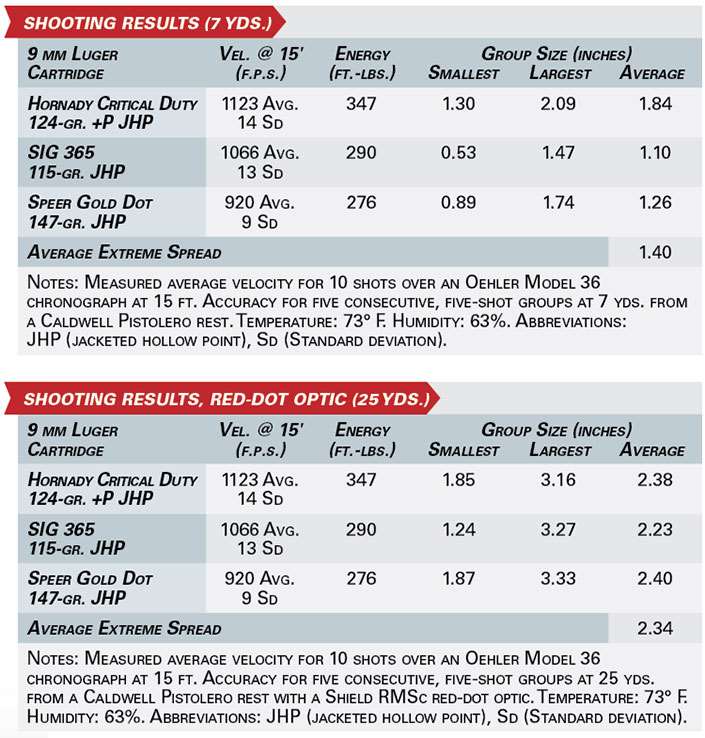
This review has been interesting for me because I don’t usually get very attached to evaluation guns, I see a lot of them in the course of a year. But this time around, the Hellcat made a mark. The only other guns I have felt so strongly about have been high-end, hand-fit M1911s—and then it was for very different reasons. The Hellcat isn’t a smooth-cycling wonder-gun that feels like an extension of my arm, possesses a feather-like trigger and is capable of bullseye precision. Nor is it a gun I envision keeping in the safe until I pass it on to my children. Simply stated, I want the Hellcat because the gun is an animal, and it’s bred to fight. It’s equipped with the latest technology, and its design meets my needs as an armed citizen. It’s small and light enough to carry and keep on me—always—and it’s potent enough to save my life if necessary.
